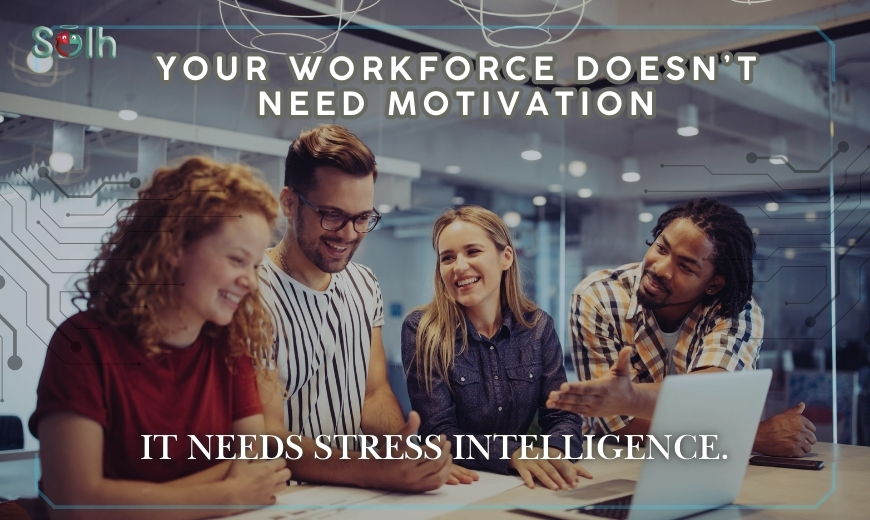We’ve Been Fighting The Wrong Battle
Over the years, organizations, HR leaders, and even individuals have been attempting to go away with unmanaged stress at workplace.
The story has always been:
- Stress is not good.
- Stress has to be eliminated.
- Stress destroys work.
- Stress destroys human beings.
However, there is something uncomfortable about this:
Stress is not your archenemy. Not taking it into consideration is.
The issue is not that your people are stressed.
The issue is that in most organizations, the rising is not observed, its emergence is not known and systems are not put in place to handle it, until it is too late.
At Solh, we believe that stress is not the villain — unmanaged stress is.
The Truth About Stress: It’s Part of Being Human
Redefining stress: Let us begin with a conceptual redefinition of the term stress:
- Stress is the message that your brain sends: “Pay attention to something.”
- An approaching deadline? That is stressful to concentrate.
- A big-time presentation? Stress, that is, making you alert.
Actually, low-level to moderate stress can usually be beneficial:
- Improve performance
- Boost creativity
- Sharpen decision-making
- Build resilience
The issue begins when the stress is a chronic one and when that elevated state becomes your everyday operating system.
Acute stress = fuel.
Chronic stress = poison.
And most organizations don’t have any mechanism to detect when their people cross that invisible line.
How Organizations Accidentally Create Chronic Stress
The majority of workplace cultures accidentally drive employees from healthy stress to toxic stress:
- Constant back-to-back meetings
- Impractical deadlines
- Role ambiguity
- Ineffective manager communication
- Digital culture of constant availability
- Silent demand of presence
And since stress does not show itself like a broken bone, leaders fail to notice it most of the time.
She appears to be okay.
He is performing in time."
"Nobody’s complaining."
And then, one day it happened - burnout, disengagements, resignations.
The Real Enemy: Organizational Blindness
Stress is not the greatest challenge that organizations are dealing with.
It is lack of early glance.
This is the ugly truth:
- Stress is hardly self-reported by workers.
- The data is seldom provided on time to HR.
- Leaders get to know when it is too late.
That is why the majority of mental health initiatives in companies are reactive ones like those after burnouts but not before.
What Organizations Have Tried — And Why It Hasn’t Worked
Traditional Solution | Why It Fails |
Annual engagement surveys | Too infrequent, outdated by the time data arrives |
Wellness webinars | Generic, not addressing root causes |
Counseling helplines | Often underutilized, stigmatized |
Mindfulness apps | Good tools but don’t fix systemic issues |
What organizations need is not another wellness app for unmanaged stress.
They need stress visibility systems that help HR and leadership intervene before employees hit breaking points.
The Solh Perspective: Build Organizational Immunity, Not Individual Toughness
At Solh, we’ve flipped the model.
Instead of saying:
- "Employees must learn to manage their stress,"
We say:
- "Organizations must help detect, monitor, and support their people through stress cycles."
This is what we call Organizational Immunity — systems that automatically sense unmanaged stress trends, proactively support employees, and prevent issues from escalating.
How Solh Builds Organizational Immunity
Let’s break it down:
Continuous Stress Monitoring with Streffie
Stress changes daily.
Waiting for quarterly HR reports is like checking your heartbeat once every 3 months.
Streffie — Solh’s AI-powered stress monitoring kiosk — allows employees to check their stress levels daily in under 60 seconds.
- Contactless face scan
- AI-based analysis (facial micro-expressions, muscle tension, skin color, eye indicators)
- Instant stress score
- Self-reflection prompts
- Personalized recommendations
No forms. No paperwork. No judgment.
Streffie transforms stress from an invisible feeling into measurable data.
Personalized Support Paths
When he notices a case of stress, Solh does not leave the employees to figure it out.
We provide:
- Problem Discovery Calls: 10-15 minute chat to find out the underlying causes.
- Talk Now: Tireless 24x7 instant chat with psychologists.
- Tool Guides: A Self-help program for the individual stressors of an employee.
- Organizational Dashboards: HR obtains combined information and does not violate privacy of employees.
Systemic Organization-Wide Insights
- Leadership and HR at last discover:
- Which ones are strained?
- What kind of stress is increasing (burnout vs. anxiety vs. fatigue)
- What are the periods associated with more stress.
- Forecasts on the trends prior to attrition or sick leaves spikes
Stress moves from “gut feel” to a business KPI.
The Business ROI of Seeing Stress Early
When organizations stop ignoring stress and start measuring it, they unlock enormous business benefits:
Cost Center | Business Impact |
Attrition | Early stress detection lowers resignation risk |
Absenteeism | Reduces medical leaves by proactive intervention |
Productivity | Stabilizes team performance under pressure |
Health Claims | Fewer chronic illness costs |
Employer Brand | Builds trust and psychological safety |
The Mindset Shift Every CXO Needs
The most progressive leaders today are not trying to eliminate stress.
They are learning to:
- Track it
- Understand it
- Support their people through it
Because stress will always exist.
But unmanaged stress will destroy organizations.
Conclusion
You do not require another wellness campaign.
You do not require another HR poster.
What you require is a Stress Management Ecosystem that will listen to your people in a quiet manner, identify the increasing stress levels early enough, and give you time to take action before it is too late.
Stress is not the enemy.
Blindness is.
Solh is here to help you finally see it.
Let’s Connect!


